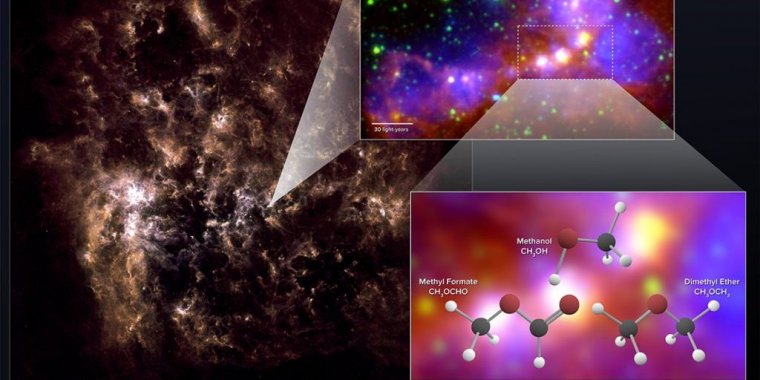| News / Space News |
Stellar Embryos in Nearby Dwarf Galaxy Contain Surprisingly Complex Organic Molecules
The nearby dwarf galaxy known as the Large Magellanic Cloud (LMC) is a chemically primitive place.

Astronomers using ALMA have uncovered chemical “fingerprints” of methanol, dimethyl ether, and methyl formate in the Large Magellanic Cloud. Image credit: NRAO/AUI/NSF; ALMA (ESO/NAOJ/NRAO); Herschel/ESA; NASA/JPL-Caltech; NOAO
Unlike the Milky Way, this semi-spiral collection of a few tens-of-billions of stars lacks our galaxy’s rich abundance of heavy elements, like carbon, oxygen, and nitrogen. With such a dearth of heavy elements, astronomers predict that the LMC should contain a comparatively paltry amount of complex carbon-based molecules.
New observations with the Atacama Large Millimeter/submillimeter Array (ALMA), however, have uncovered the surprisingly clear chemical “fingerprints” of the complex organic molecules methanol, dimethyl ether, and methyl formate.
Though previous observations found hints of methanol in the LMC, the latter two are unprecedented findings and stand as the most complex molecules ever conclusively detected outside of our galaxy.
Astronomers discovered the molecules’ faint millimeter-wavelength “glow” emanating from two dense star-forming embryos in the LMC, regions known as “hot cores.”
“Even though the Large Magellanic Cloud is one of our nearest galactic companions, we expect it should share some uncanny chemical similarity with distant, young galaxies from the early universe,” said Marta Sewiło, an astronomer with NASA’s Goddard Space Flight Center in Greenbelt, Maryland.
The astronomers focused their study on the N113 Star Formation Region in the LMC, which is one of the galaxy’s most massive and gas-rich regions.
Earlier observations of this area with NASA’s Spitzer Space Telescope and ESA’s Herschel Space Observatory revealed a startling concentration of young stellar objects – protostars that have just begun to heat their stellar nurseries, causing them to glow brightly in infrared light.
At least a portion of this star formation is due to a domino-like effect, where the formation of massive stars triggers the formation of other stars in the same general vicinity.
Complex organic molecules, those with six or more atoms including carbon, are some of the basic building blocks of molecules that are essential to life on Earth and – presumably – elsewhere in the universe.
Though methanol is a relatively simple compound compared to other organic molecules, it nonetheless is essential to the formation of more complex organic molecules, like those that ALMA recently observed, among others. (National Radio Astronomy Observatory)
YOU MAY ALSO LIKE


